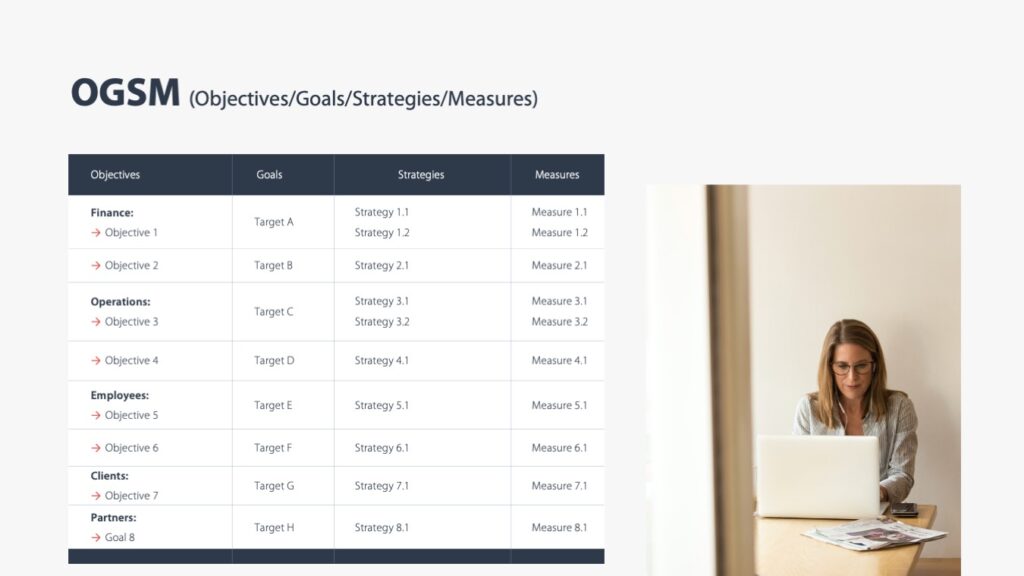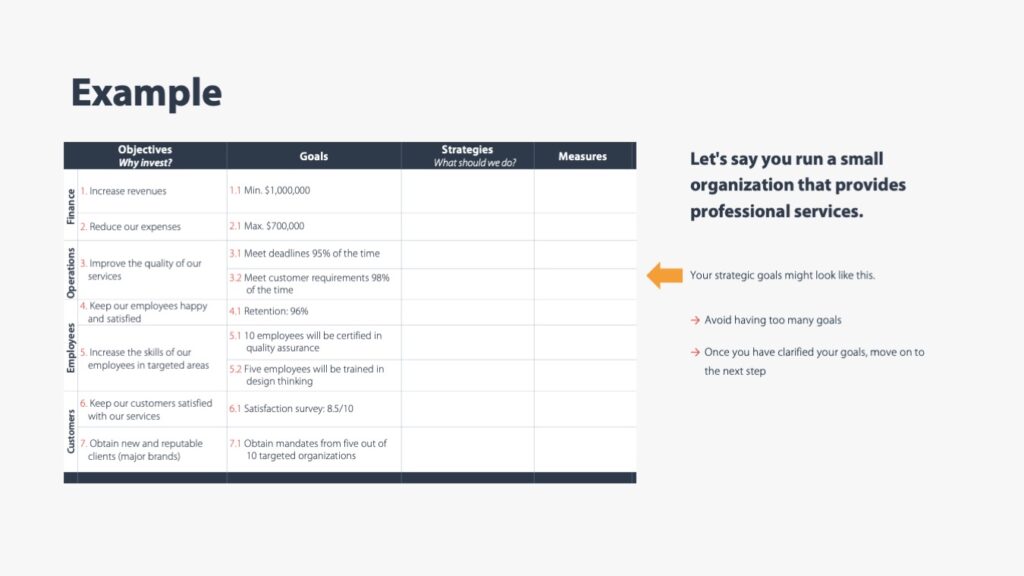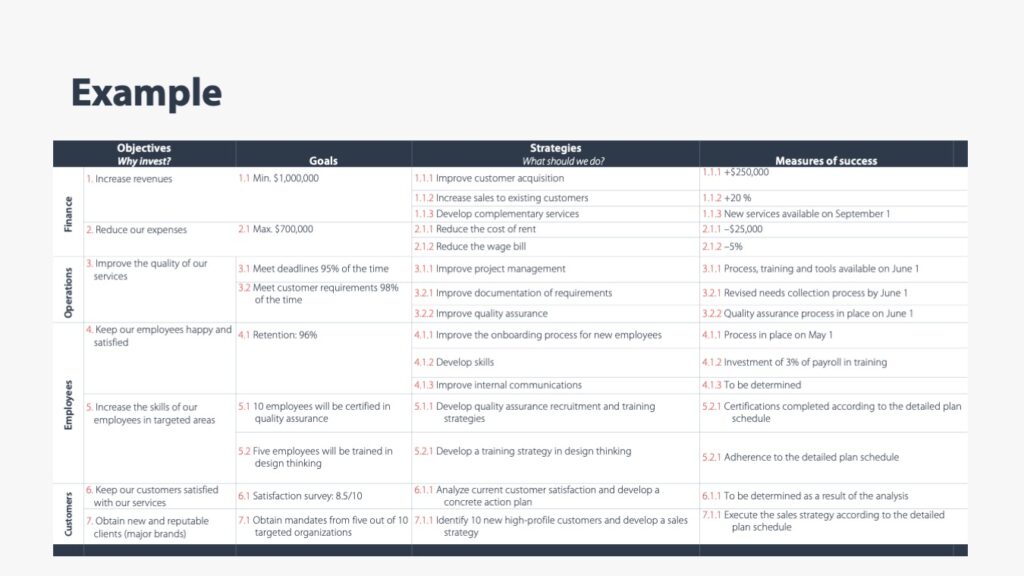Small Business or Small Team: Do Your Strategic Planning!
THIS ARTICLE WAS PUBLISHED ON REVUE GESTION WEBSITE.
Many managers fear that developing a strategic plan is a waste of time. Indeed, the process is often arduous and misunderstood, and it usually produces a cumbersome document that will quickly be set aside. Faced with the imperatives of daily operations, the path forward seems to be self-evident; so why invest time in strategic planning?

To ensure its longevity, every organization must evolve. The status quo is never an option, as the market evolves, technologies advance, and society transforms. Therefore, the strategic plan aims to determine towards what the organization should evolve and in which ways.
Without a strategic plan, it’s agreed that decisions are dictated by momentary circumstances, rather than a long-term perspective. If you’re only reacting to events, it’s likely that promising opportunities will be overlooked, or a winding path will be taken due to a lack of clarity about the destination. Indeed, if you don’t know exactly where you want to go, how can you ensure you’re taking the best path?
Whether you’re responsible for a small or large business, a department, or a team, clarifying your objectives, developing your strategies, and detailing your action plans are essential for the success of your evolution.
More specifically, developing a strategic plan has many benefits, including:
- It establishes a common target and rallies all contributors. Deciding together on the precise objectives to be pursued in the coming year is a significant step in itself. If this conversation does not take place, it is highly likely that the objectives will be vague or even contradictory among the different contributors.
- It facilitates decision-making consistent with the targets. When objectives are clear and strategies established, daily decisions are no longer improvised; they are made within the parameters agreed upon in strategic planning. These choices speed up decision-making and increase the chances of achieving the expected results.
- It increases the probability of reaching the targets. Reflective time involving collective intelligence increases the probability not of investing efforts and money in sub-optimal initiatives due to lack of analysis and overall perspective, but rather of betting on the most promising opportunities.
- It allows for measuring progress and adjusting as needed. With a plan of the steps you need to reach the target you have set, it is possible and necessary to measure progress and then adjust as needed. However, if the path is not mapped out, how can you know if you have strayed from your course?
Strategic planning can obviously be a vast initiative if it considers all the activities of a large organization. However, if your own organization is small, you have the option to scale your efforts using the OGSM model (for Objectives, Goals, Strategies, and Measures), which comes from Japan and dates back as far as 1950. Despite everything, it is still adopted by a very large number of organizations today.
The OGSM model can be represented by a simple table. So, it’s not a document with an infinite number of pages!

Let’s see how to proceed.
First, focus on clarifying your strategic objectives and their targets
In relation to the next year (or the next three years, depending on relevance), a strategic objective answers the following question: why invest efforts and financial resources?
Indeed, the first step is to identify why efforts and amounts of money should be invested, beyond those necessary for daily operations. This will describe what the organization should strive towards.
To ensure you don’t overlook any aspect essential to the evolution of your organization, one or more strategic objectives should be identified for each of the following categories:
- Finances
- Operations (operational processes)
- Employees
- Customers
- Partners (if relevant to your organization)
Additionally, each strategic objective corresponds to a concrete goal to be achieved, ideally quantifiable, which answers the following question: what results do you want to achieve?
Let’s start with a simple example: imagine you are the head of a small company that offers professional services. How do you want to evolve in the next year?
Let’s see what your strategic objectives might look like:

Be careful in selecting your objectives and targets; thus, avoid choosing too many. It’s better to focus on a limited number of objectives and achieve them than to dissipate your efforts and obtain mediocre results.
Once the objectives are clarified and agreed upon by your team members, you can move on to the next step, which is about strategies.
Identify the most promising strategies and their success measures
A strategy determines what needs to be done to achieve an objective. It essentially answers the following question: what do we need to do to achieve our goal?
An objective may require more than one strategy, and a strategy may be useful for more than one objective.
A strategy does not explain how the objective should be achieved, but rather what needs to be done. It answers the “what” question, not the “how.” A common mistake is to focus on the latter. By detailing the “how,” you risk not considering original and promising strategies. Or even wasting substantial time detailing a strategy that will not be selected. Or, worse yet, creating confusion and reducing everyone’s ability to correctly assess priorities.
The goal is first to define as many strategies as possible, before choosing the most promising ones. Here are some questions that might inspire you with essential strategies for your success.
What do we need to achieve a given goal in terms of…
… capabilities? List the elements required to achieve your goal. For example, improving our project management capabilities. … skills? Think about additional skills that might be necessary. … management systems? Consider the tools and processes that are essential on your side.
For each identified strategy, determine its success measures. To what extent does each strategy contribute to achieving the target set for one or more objectives?
As a first step, think broadly. Consider many strategies. Consult your colleagues, employees, partners, and clients.
Afterward, assess the efforts—small, medium, high—that are required to execute each of the strategies, then the benefits that will be generated – small, medium, high. You will, of course, want to prioritize strategies with high benefits that require the least possible effort. Eliminate the least promising ones, and you will have made informed choices, rather than reacting to daily issues.
In our example, let’s see what this could look like:

You will already have a tool conducive to communication in your hands. Since it will fit on one or two pages, you will easily be able to discuss it with your colleagues, employees, and investors and give them an overview of your intentions.
Create Your Action Plans
When the strategies are clearly identified, it’s just a matter of developing the action plans for each of these, which you will document separately (i.e., one action plan per strategy). You then determine how you will proceed. This part is the easiest once the objectives are clear and the strategies have been well identified.
An action plan lists all the activities that need to be carried out sequentially, the responsible individuals for each activity, and the planned timelines.
It often becomes necessary to make a consolidated plan, which includes the main milestones of all the action plans. This gives you an overview, a valuable tool for later measuring the organization’s progress. Rest assured that adjustments will be made over time, as events rarely unfold in the way you imagined at the start. However, navigating blindly would be even worse.
Imagine the discussions necessary to develop your strategic plan. To arrive at common objectives and their targets, and to define priorities among the stated strategies and their success measures, each member of the management team will need to express themselves. This will lead to great clarity regarding the aspirations shared by the entire organization and achieve perfect alignment of decisions and invested efforts, which would have been impossible to achieve without going through such a process.
The exercise itself is even more important than the resulting plan.
Receive valuable advice.
Subscribe to our newsletter and regularly receive strategic insights, inspiring articles, and useful resources directly in your inbox.
We are committed to sharing only high-quality content to enrich your leadership journey. Sign up now!
Receive valuable advice.
Subscribe to our newsletter and regularly receive strategic insights, inspiring articles, and useful resources directly in your inbox.
We are committed to sharing only high-quality content to enrich your leadership journey. Sign up now!
You may also like…
We are subjected to 11 million pieces of information per second.
READ MOREMaking an informed decision can be perilous. We are often faced with complex situations, lack of time, numerous distractions and strong emotions. Fortunately, advances in...
READ MOREIn a constantly evolving world, managers are always on the lookout for new talents and skills to meet the challenges they face. However, the "crucial...
READ MORE

